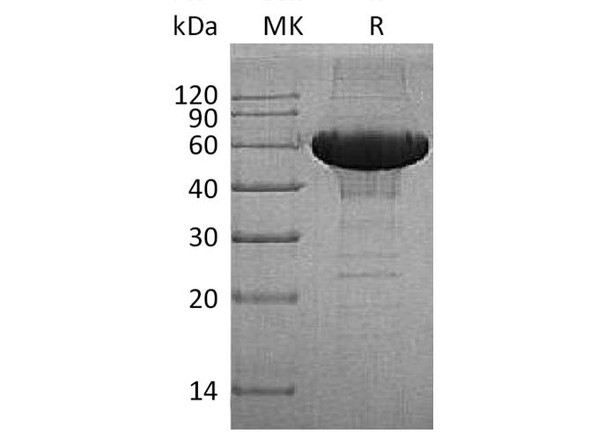Enzymes Recombinant Proteins
Human MMP 3 Recombinant Protein (RPPB5819)
- SKU:
- RPPB5819
- Product Type:
- Recombinant Protein
- Species:
- Human
- Uniprot:
- P08254
- Research Area:
- Enzymes
Description
| Product Name: | Human MMP 3 Recombinant Protein |
| Product Code: | RPPB5819 |
| Size: | 10µg |
| Species: | Human |
| Target: | MMP 3 |
| Synonyms: | Stromelysin-1, EC 3.4.24.17, Matrix metalloproteinase-3, MMP-3, Transin-1, SL-1, STMY, STR1, STMY1, MGC126102, MGC126103, MGC126104. |
| Source: | HEK293 Cells |
| Physical Appearance: | Sterile Filtered colorless solution. |
| Formulation: | The MMP-3 is supplied as a 0.2�m filtered solution in 20mM Tris-HCl, 150mM NaCl and 0.05% Brij35, pH 7.5. |
| Stability: | Store at 4°C if entire vial will be used within 2-4 weeks. Store, frozen at -20°C for longer periods of time.Avoid multiple freeze-thaw cycles. |
| Purity: | Greater than 95% as determined by SDS-PAGE. |
| Biological Activity: | The activity was measured by its ability to cleave the fluorogenic peptide substrate, Mca-RPKPVE-Nval-WRK(Dnp)-NH2. The specific activity is > 150 pmoles/min/�g.Recombinant Human MMP-3 protein pro form needs to be activated with Chymotrypsin.Activation Protocol:1. Dilute MMP3 to 20�g/ml in the Assay Buffer: 50mM Tris, 10mM CaCl2, 150mM NaCl, 0.05% (w/v) and Brij 35, pH 7.5.2. Activate MMP3 by adding Chymotrypsin(Sigma, Catalog#C�3142,1mg/ml stock in 1mM HCl) to a final concentration of 5ug/ml.3. Incubate at 37�C for 30 minutes.4. Stop activation with 2mM PMSF. Pre-warm the PMSF to 37�C prior to adding to sample. |
MMP-3 enzyme is also known as Stromelysin-1or as Transin-1 which hydrolyzes natural collagen at physiological pH and temperature. It dissolves the intervertebral nucleus pulposus and annulus fibrosus of Herniated Lumbar Intervertebral Disk . MMP-3 hydrolyzes components of the extracellular matrix like proteoglycan, laminin, fibronectin, gelatin and collagen types III, IV and IX. It also activates pro-MMP-9 and pro-MMP-8 and superactivates plasmin activated MMP-1. MMP-3 is secreted as a latent proenzyme and is activated by a variety of proteinases, e.g. plasmin, trypsin, chymotrypsin, cathepsin G or human neutrophil elastase. MMP-3 was found to be capable of activating the precursor of IL1-beta.
MMP-3 Human Recombinant produced in HEK293 cells is a proform of the Human MMP3 [Tyr18-Cys477 (Lys45Glu)] and fused with a ployhistide tag at the C-terminus, having an Mw of 52kDa. MMP-3 is purified by proprietary chromatographic techniques.
| UniProt Protein Function: | MMP3: Can degrade fibronectin, laminin, gelatins of type I, III, IV, and V; collagens III, IV, X, and IX, and cartilage proteoglycans. Activates procollagenase. Defects in MMP3 are the cause of susceptibility to coronary heart disease type 6 (CHDS6). A multifactorial disease characterized by an imbalance between myocardial functional requirements and the capacity of the coronary vessels to supply sufficient blood flow. Decreased capacity of the coronary vessels is often associated with thickening and loss of elasticity of the coronary arteries. A polymorphism in the MMP3 promoter region is associated with the risk of coronary heart disease and myocardial infarction, due to lower MMP3 proteolytic activity and higher extracellular matrix deposition in atherosclerotic lesions. Belongs to the peptidase M10A family. |
| UniProt Protein Details: | Protein type:Secreted; EC 3.4.24.17; Motility/polarity/chemotaxis; Secreted, signal peptide; Protease Chromosomal Location of Human Ortholog: 11q22.3 Cellular Component: proteinaceous extracellular matrix; extracellular space; mitochondrion; extracellular region; cytosol Molecular Function:zinc ion binding; metalloendopeptidase activity; endopeptidase activity; calcium ion binding Biological Process: extracellular matrix disassembly; positive regulation of protein oligomerization; collagen catabolic process; extracellular matrix organization and biogenesis; negative regulation of protein kinase B signaling cascade; protein catabolic process; proteolysis; regulation of cell migration Disease: Coronary Heart Disease, Susceptibility To, 6 |
| NCBI Summary: | Proteins of the matrix metalloproteinase (MMP) family are involved in the breakdown of extracellular matrix in normal physiological processes, such as embryonic development, reproduction, and tissue remodeling, as well as in disease processes, such as arthritis and metastasis. Most MMP's are secreted as inactive proproteins which are activated when cleaved by extracellular proteinases. This gene encodes an enzyme which degrades fibronectin, laminin, collagens III, IV, IX, and X, and cartilage proteoglycans. The enzyme is thought to be involved in wound repair, progression of atherosclerosis, and tumor initiation. The gene is part of a cluster of MMP genes which localize to chromosome 11q22.3. [provided by RefSeq, Jul 2008] |
| UniProt Code: | P08254 |
| NCBI GenInfo Identifier: | 116857 |
| NCBI Gene ID: | 4314 |
| NCBI Accession: | P08254.2 |
| UniProt Secondary Accession: | P08254,Q3B7S0, Q6GRF8, B2R8B8, |
| UniProt Related Accession: | P08254 |
| Molecular Weight: | 53,977 Da |
| NCBI Full Name: | Stromelysin-1 |
| NCBI Synonym Full Names: | matrix metallopeptidase 3 (stromelysin 1, progelatinase) |
| NCBI Official Symbol: | MMP3�� |
| NCBI Official Synonym Symbols: | SL-1; STMY; STR1; CHDS6; MMP-3; STMY1�� |
| NCBI Protein Information: | stromelysin-1; transin-1; proteoglycanase; matrix metalloproteinase-3; matrix metalloproteinase 3 (stromelysin 1, progelatinase) |
| UniProt Protein Name: | Stromelysin-1 |
| UniProt Synonym Protein Names: | Matrix metalloproteinase-3; MMP-3; Transin-1 |
| Protein Family: | Stromelysin |
| UniProt Gene Name: | MMP3�� |
| UniProt Entry Name: | MMP3_HUMAN |






